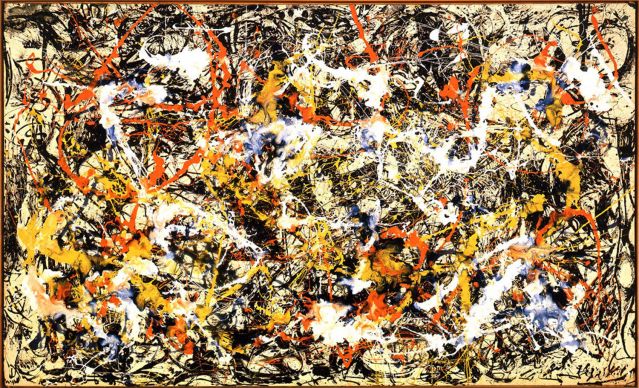Beauty
The Slow Art Movement: It's More than Meets the Eye
Our art experience should drive our sensations, thoughts, and feelings.
Posted November 22, 2014
I used to think that it was my duty at an art museum to stand in front of every artwork and admire each one as an expression of creative beauty. How long would that take? Jeffrey and Lisa Smith, two prominent scientists in the field of empirical aesthetics, observed visitors at the Metropolitan Museum of Art in New York and recorded the time they spent viewing six masterpiece artworks. Answer: 17 seconds per artwork (Smith & Smith, 2001). That's it—though considering our fast-paced, short-attention span, tweeting society, 17 seconds to some may actually seem like a long time. In any event, in recent years the Slow Art movement has sought to quiet the pace of our art viewing experience and change the way we approach art.

Convergence, 1952, Jackson Pollock, Albright-Knox Art Gallery, Buffalo, N.Y.
Like the Slow Food movement, the Slow Art movement is grounded on the premise that one should savor artworks in a conscious and deliberate manner rather than simply gulp each one down as "eye candy." Phil Terry conceived the idea in 2008 when he spent hours at the Jewish Museum in New York focusing primarily on two abstract paintings—Hans Hoffman’s Fantasia and Jackson Pollock’s Convergence. A year later, 16 museums initiated an official Slow Art Day at which visitors signed up to view five artworks with a volunteer host and spent 10 minutes with each piece. They were invited to meet afterwards for lunch to discuss the experience. Since then, over a hundred museums and galleries have participated in what has now become an annual event—in 2015 the official Slow Art Day will be held on April 11 very likely at a museum near you. According to the organizers, it is the goal of the beholder to contemplate art and take in the sensory experience as a meditative event. They want you to attend to the artwork itself rather than spend time considering background information, such the printed notes next to an artwork.
Others have followed and extended the notion of a deliberative art experience, though not exactly as espoused by proponents of the Slow Art Movement. For example, artnet.com has showcased "Strictly Critical Videos" in which Blake Gopnik and Christian Viveros-Fauné, two insightful art critics, spend an hour focusing on an artwork (each video shows only 5 minutes of their analysis). So far, they have spent time looking at a Pollock, a Vermeer, and most recently several works at the Jeff Koons retrospective currently showing at the Whitney Museum of American Art. As one might expect, these two rather vociferous art critics do not adhere to the tenets of the Slow Art Movement by merely standing in front of an artwork in a contemplative or transcendental manner. Instead, they spend their one hour considering the artwork within the context of art history, and thus it is full of background information. In other words, critics Gopnik and Viveros-Fauné do exactly what is a no-no with respect to the Slow Art Movement—they use their expanse background knowledge to consider the meaning of an artwork. When considered in this manner, it is easy to see how two knowledgeable individuals can spend an hour talking about a particular artwork as there can be much to say with respect to an artwork's cultural and historical significance (and it is fun to listen to them do it—only it would be even more fun to have access to the entire one-hour conversation).
The distinction between the Slow Art Movement and the Strictly Critical Videos captures the contrast between the typical museum-goer, who looks at art for a sensory and emotional experience, and the typical art expert, who focuses on the conceptual nature of an artwork, as if it is an expression of an idea—preferably a novel chapter in the story of art. I have advocated that our art experience should be grounded on highlighting sensations, knowledge, and emotions. That is, an artwork should be considered in the ways it drives our entire psyche. Thus, for every artwork we find interesting (which of course will likely not be every artwork in a gallery), we should take in its visual quality and generate feelings from it. Thus, I applaud the Slow Art movement in encouraging museum-goers to spend more time contemplating selective artworks. However, the experience should not stop there. In order to consider the conceptual nature of an artwork it is vital to have background knowledge, which can come from prior knowledge, a printed card next to an artwork, and any other information available—perhaps information on the walls as you enter an exhibition, an audioguide, a docent (or knowledgeable friend), or even information gleaned from your smartphone.
In the end, our art experience can be most exciting when our senses, knowledge, and emotions are all jacked up to 11 on a scale of 10. Indeed on those rare occasions when I get that "wow" feeling, it is usually because an artwork completely captures the moment to the point where there is nothing else except me and the artwork. In addition to these sublime moments, whenever I visit an art museum, it is as much of a learning (i.e., conceptual) experience as it is an "aesthetic" (i.e., emotional) one. What can we learn from new works of art? How can an artwork be placed within the story of art? What is the artist trying to say? By considering such conceptual questions with others, our art experience can also be an exciting social event as well. Seeing, learning, and feeling—these should be the features of our art experience be it at a museum, outside, or on the web, and the next time you encounter something that you like or find interesting, take the time to consider why.


